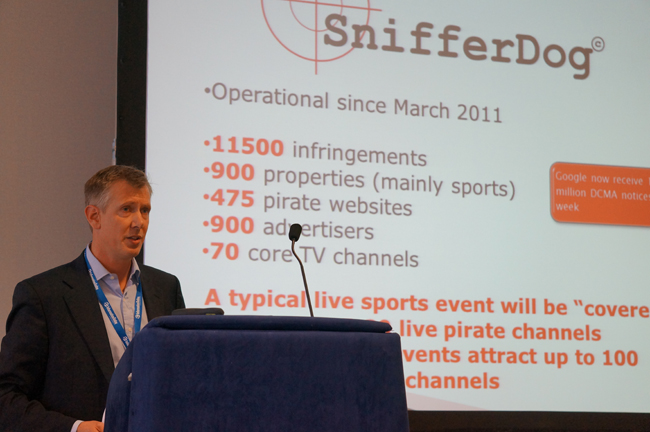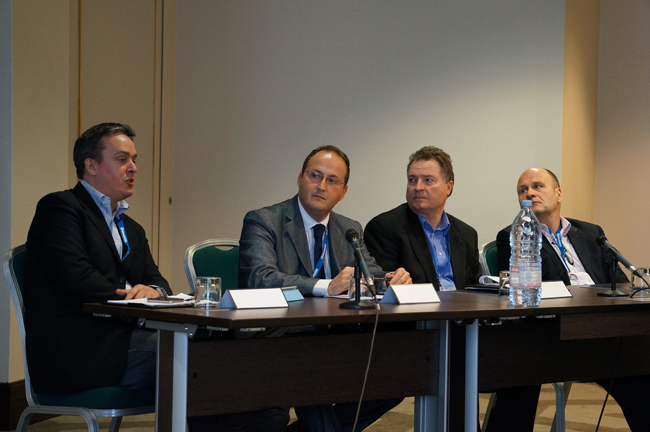Tactics to Combat Video Piracy Are Shifting, Finds VIS Panels
Kicking off the first of two sessions at the 2012 Video Infrastructure Summit on piracy, Peter Lewinton, managing director of Klipcorp Ltd., spoke on piracy in live sports video, then joined a panel tackling the same topic.
In a presentation titled "Measuring the Impact of Piracy for Rights Holders, Hosting Companies, ISPs, and Advertisers", Lewinton noted straight off that piracy is big business.
"Pirated content takes up to 24 percent of internet bandwidth globally, according to The Information Technology and Innovation Foundation," said Lewinton. "Our company tracks infringements for our customers, who are primarily sports channels that stream live sporting events."
Over the past few years, Klipcorp has tracked nearly 11,500 infringements over 900 mainly sports properties.
"We've tracked 475 pirate websites, and typical live sports event will be 'covered' by 15 to 20 live pirate channels. High profile events, though, can attract up to 100 channels," said Lewinton

According to Lewinton, Google now receives over 1.5 million DCMA takedown notices per week.
While most information around piracy's financial loss impact isn't detailed, at least in regards to how the numbers were derived, the scale of piracy losses is 10 billion Euros across the European Union (EU). This amount is against the backdrop of creative industries' contribution of approximately 680 billion euros to the EU market as a whole.
"Rattler is a new piracy approach that allows pirate set-top boxes for OTT or encrypted capture cards on set-top boxes," said Lewinton. "In some instances in Africa, pirated set-top boxes can cost no more than 150 percent of a single-month legitimate subscription, resulting in market penetration of pirate set-top boxes at levels exceeding 90 percent of all content consumption."
Over 900 advertisers pay to be on these pirate services.
"Pirate distribution and the major pirate sites' addressable market is bigger than a typical local station," said Lewinton, noting that a significant number of advertisers market on these sites, since the cost per click (CPC) is lower and the reach is wider than legitimate sports sites.
"OTT pirate content is global, has no rights costs, and nominal technical costs versus the regional nature, rights fees, and technical costs facing the cable, IPTV, satellite, and legitimate OTT industry," said Lewinton.
"Boxing is fairly heavily pirated, but Klipcorp IP has played an important part in shifting that model," noted Lewinton. "For instance, the new BoxNation channel has become the largest non-Sky sports channel on the Sky platform. In the last year it has reached over 200,000 paying subscribers using effective management of online piracy."
The second piracy session, a panel on security and anti-piracy, included panelists from Civolution, Intertrust, Microsoft, and Vualto. Microsoft offers PlayReady digital rights management (DRM), Civolution provides watermarking and digital fingerprinting services, and Vualto offers both PlayReady and other DRM schemes to its customers. Intertrust, once a public company and now privately owned, was one of the companies involved in the creation of Marlin -- an open-source DRM scheme -- along with Panasonic, Philips, Samsung, and Sony.

"In the last three to four years," said Massimo Savazzi, a Microsoft senior business development manager for EMEA, "we've seen a shift from DRM -- which protects the physical asset -- to protecting ecosystem revenue streams.
"If there is no revenue, protecting the content asset itself is irrelevant," he continued. "Security is not a technology, it is a service. So, what we are protecting today is not just subscription, premium VOD services, but also advertising-based content by focusing on everything from the silicon vendors and codecs to content owners and broadcasters."
James Burt, co-founder of Vualto, says that broadcasters use a mix of DRM schemes.
"This is due to a number of workflows within the broadcasters, but the bottom line is that it all has to be seamless to the user," said Burt.
Intertrust's EMEA general manager, Oliver Mills, noted that proprietary DRM schemes hit the market first, and then open standards mature and offer an alternative to proprietary DRM.
"DRM will move increasingly to open standards, including the move to delegated trust authorities, so that there is interoperability between open-source DRM systems," said Mills. "We've continued to have interest from broadcasters who don't want to lock into a single vendor's ecosystem."
"We take a different approach, more like the one the late Steve Jobs championed," said Civolution's Andy Nobbs, "where we want the ecosystem aware of who owns the content. As such we offer up services around digital watermarking and fingerprinting, rather than blocking access to the content via DRM.
"In this way, we can identify content for our customers, so that they can also see the path all the way down to the consumer that is consuming the content."
Scroll down to watch a video of both sessions:
Related Articles
It's time to give the people what they want and let them enjoy their movies anytime, anywhere, and on any device.
06 Apr 2012
With new technologies, digital rights management is working in the background -- or in the cloud -- and staying out of the viewer's way, says Irdeto.
27 Mar 2012
DRM will always have a place, but content owners should spend more time creating innovative distribution models like Netflix that are easy-to-use and priced right.
09 Feb 2012